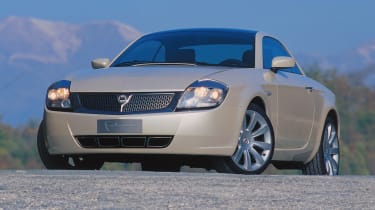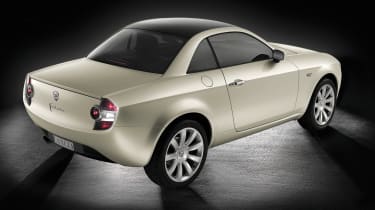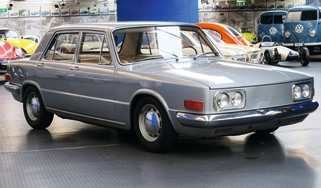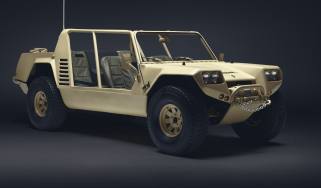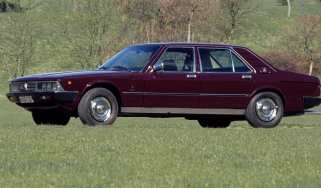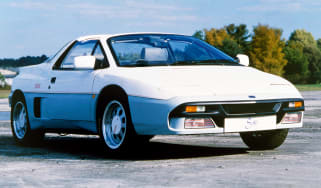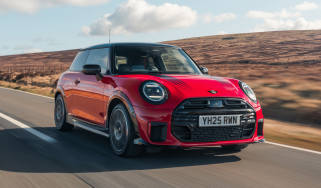Lancia Fulvia Coupé – dead on arrival
It could’ve re-ignited a lust for Lancias, but instead this retro two-seater stalled at the concept stage
Lancia entered the 21st century in a dull rut, pedalling one small hatchback, one large people carrier and two unappealing saloons while the defunct Delta Integrale became an ever-smaller speck in its corporate mirrors. Fortunately, the company’s Style Centre had a plan to make Lancia interesting again.
Using the 1965 Fulvia Coupé as their starting point, designer Alberto Dilillo and design director Flavio Manzoni masterminded a gorgeous evocation, blending the perfect stubby stance of the source material with 2000s-spec sheer body surfacing and the swept-back headlights of other Lancias to come. The finished clay model was bright and beautiful in Italian racing red, but for the all-metal show car the designers decided to spray it in elegant light gold, complementing the brown leather interior and the bespoke Trussardi bags in the Alcantara-lined boot.
> Panther Solo 1 – dead on arrival
The Fulvia Coupé concept was shown for the first time at the 2003 Frankfurt show on a Lancia stand brimming with a new-found confidence that stretched from the resin floors to the upstairs Martini bar. At its centre, the star of the show, proudly mounted on a stage within a pebble-lined water feature, looking sexy and glamorous yet conspicuously showroom ready.
No concept-car silliness here: the Fulvia Coupé had normal door handles, proper mirrors and realistically configured intakes for cooling and ventilation. There were even side repeaters. And underneath the winsome skin was the Punto-derived front-wheel-drive chassis of the Fiat Barchetta, with that car’s 1747cc engine, though wearing a new cover labelled ‘4.16’. From the people who brought you the Thema 8.32. The concept was claimed to weigh just 990 kilos thanks to aluminium panels hand formed by Italian prototyping firm Cecomp, which created the driveable show car by dismembering a red Barchetta and then fabricating everything around its steel hull.
‘If we could find 2000 to 2500 buyers eager to pay around €35,000 for the Fulvia Coupé,’ said Lancia’s then boss, Luca de Meo, ‘this car could be built.’ Though the price sounded high, the target volume seemed low and surely the Fulvia was a shoo-in for production? Well, not quite. First of all, there was the question of where to make such a small-batch car. The best hope was a coachbuilder such as Zagato, who, rumour had it, had already been consulted about the project. Another problem was the Barchetta platform, which was getting old and due to die within the next two years. Perhaps the Fulvia would need to move to a different donor model. Then there was the biggest problem of all: Fiat’s dire financial state at the time, which meant signing off a low-volume model from a waning subdivision was a low priority. Soon after the Coupé’s triumphant 2003 debut all talk of a production run faded to nothing.
But that wasn’t the end for the reborn Fulvia because three years later, with Fiat on the mend, boss man Sergio Marchionne bullishly claimed ‘we never said we would not make it’, adding that fans of the concept should ‘stay tuned’. Some media speculated that, with the Barchetta now dead, the concept’s style would be reconfigured onto the Grande Punto platform, while Italian magazine Quattroruote claimed a new Fulvia was written into the Lancia product plan for 2008, now with a folding metal roof and based not on a Fiat but around the larger Alfa Brera/Spider chassis.
In the end, Marchionne gave Fulvia fans nothing to stay tuned for at all, preferring to put his money into an endless series of Alfa Romeo reinvention plans while Lancia was allowed to wither. De Meo, now CEO of Renault, has since called the Fulvia’s failure to reach production ‘one of my biggest professional regrets’. Still, at least he can pay a rueful visit to the one-off show car, which lives in the Stellantis ‘Heritage Hub’ museum in Turin.
This story first featured in evo issue 308.
